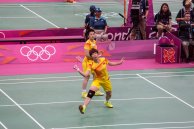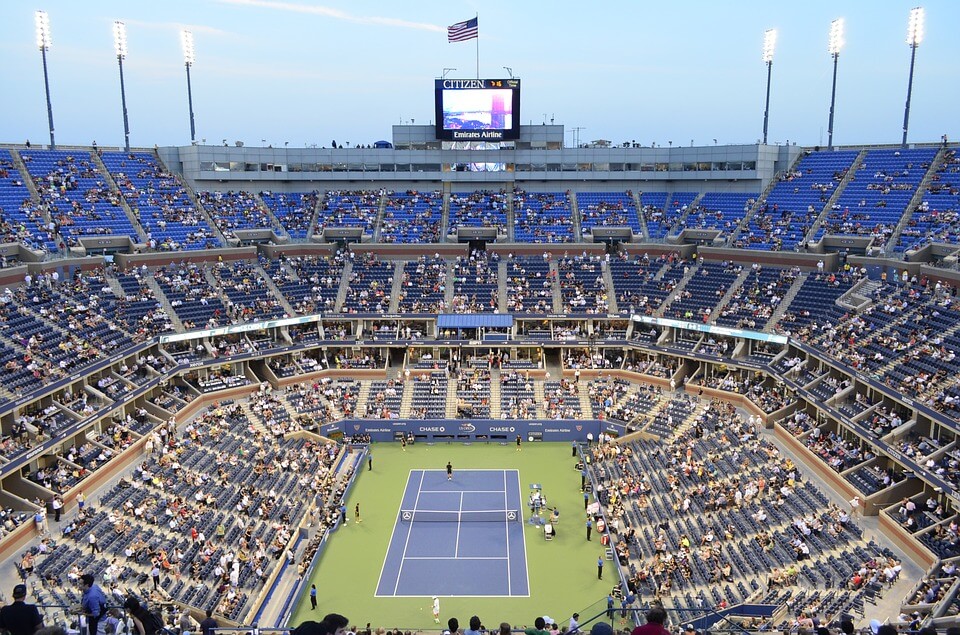
We all know the types of tennis courts on which the main Grand Slam are developed. Indeed we are talking about the Australian Open, Roland Garros, Wimbledon and the US Open.
But depending on the surface we play, we must adopt one strategy or another in our game. However, and as you know, depending on each geographical area, and even certain countries, there are more or more different types
But if you want to know more about the different tennis courts and their surface types and how to focus your game, read on. On another article, we have also talked about the best tennis racquet for beginners.
What are the Types of Tennis Courts
Before we begin, we will talk, of course, about the dimensions of a tennis court, little treated and not all of us know. The tennis court dimensions are generally 23.78 meters long and 10.97 meters wide, with a distance to the bottom equal to or greater than 3.65 meters (4 m in international tournaments) and space next to the side, equal to or larger than 6.40 meters (8 m in international tournaments).
The tennis net is the key element of this sport, in addition to tennis shoes it is evident, and should be at a height of 0.914 m. to the center and 1.07 m. in the posts that affirm it. Following, the tennis net must be suspended by a metal cable of 0.8 m in diameter and covered by the famous white band (also called tape), which interferes at several points. The posts on which the net sits must be fixed at a distance of 914 cm. from the doubles line, have no more than 15 cm. in diameter and not exceed 2.3 cm. height above the height of the net. Here you can see the types of the tennis court and their dimensions from above with the measurements of a tennis court:
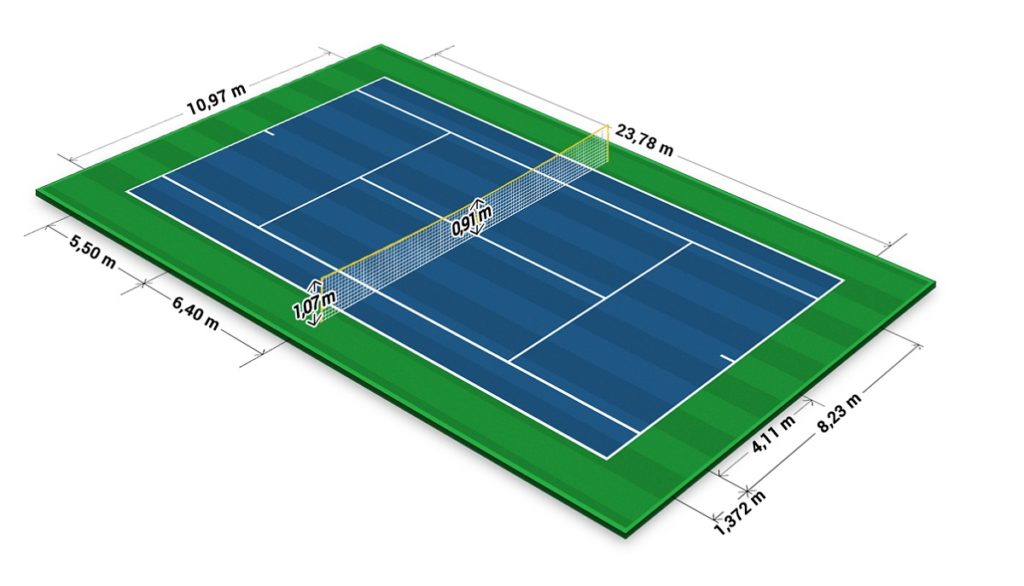
All tennis surfaces await a great champion who gives the recognition he deserves to each. However, the different types of courts always favor the type of game of some tennis players, more than others. But what are they?
Hard Tennis Court
Without a doubt, Hardcourt is one of the best known to all and the most abundant in all tennis clubs in our country. On the other hand, along with the clay court is one of the most played by tennis fans in Spain.
In these types of tennis courts is where everyone, sooner or later, has begun to learn their first strokes, and without a doubt, has developed its breadth of play.
It is a type of tennis court that is very widespread in the vast majority of countries where our king sport is practiced, since the type of game that it requires is not excessively technical, as it can be in the rest of tennis courts.
In addition, a large number of tennis courts are hardcourt just because of its cheaper and better. The investment needed to build a hard tennis court is less than the rest of the courts, also adding the economic costs of maintaining it.
Although it is true, these types of tracks are relevant thanks to Master 1000 tournaments such as Indian Wells, Miami or the Grand Slam of the Australian Open and US Open (Here we can see a tennis court from above ).
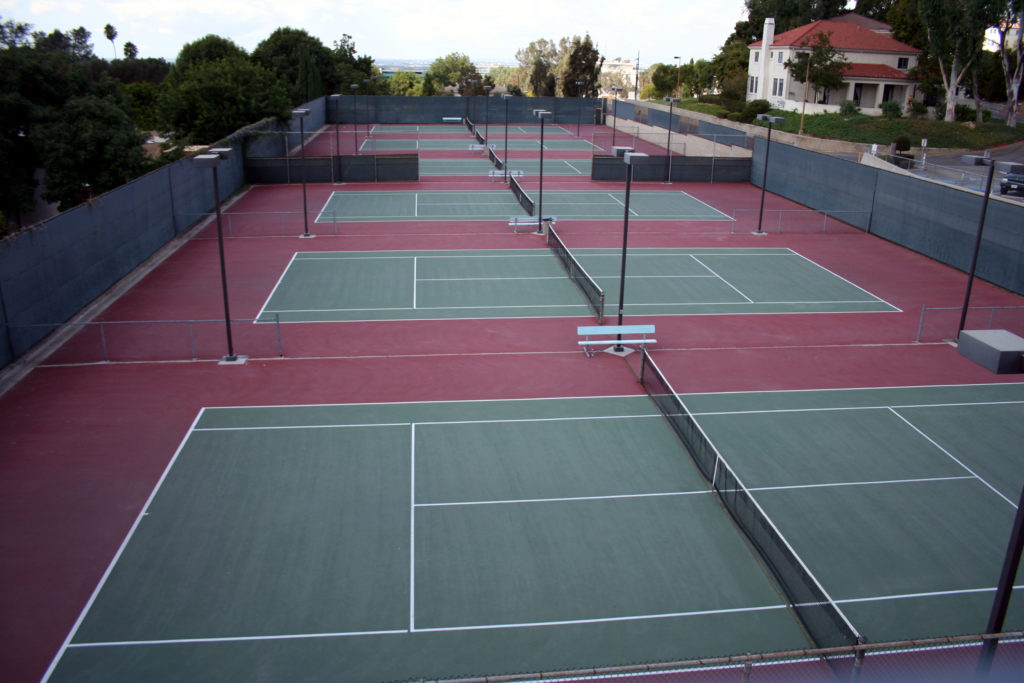
Finally, as for the clothing necessary for the game on this type of surfaces, we would highlight, without a doubt, some shoes whose sole is striated with the aim of “grabbing” the surface well and facilitating movement.
Grass Tennis Court
If we had to highlight a surface little frequented by tennis players, at least in Spain, we would choose the grass tennis court, rarely played by amateur tennis players.
We usually know them for playing in the great professional tournaments like Queen´s, s ́hertogenbosch or, of course, Wimbledon. Who does not remember the great points lived in these tracks by Roger Federer, Rafa Nadal, Pete Sampras, or Conchita Martínez?
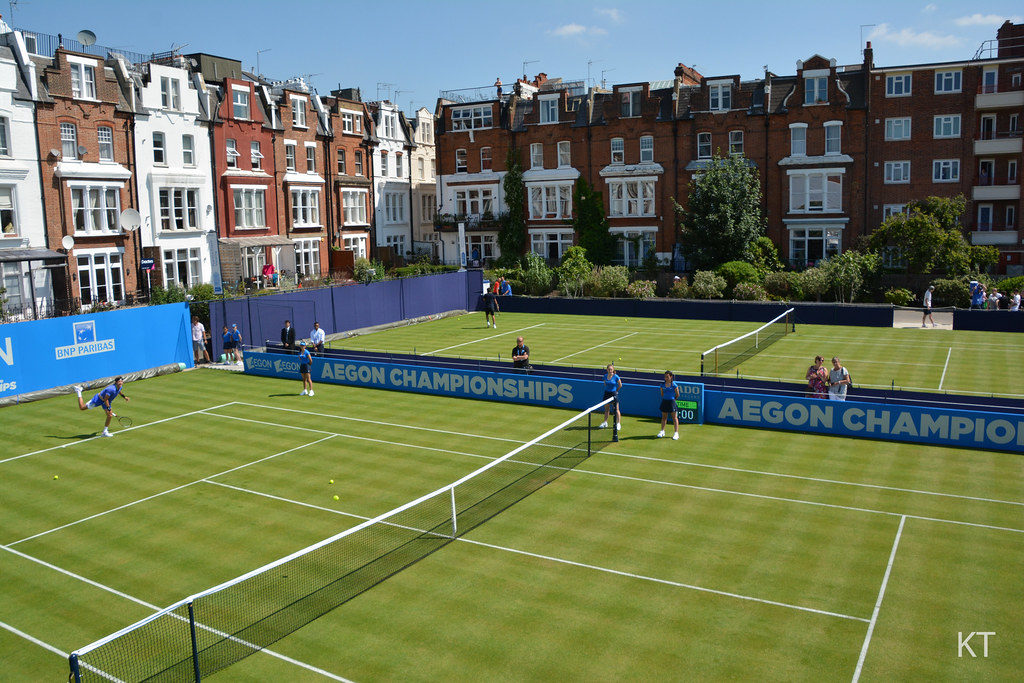
Of course, the tennis court and its measurements remain exactly the same as in the rest of the surfaces.
But if we had to highlight something, it would be the abundance of these types of tennis courts in Anglo-Saxon countries (England, Wales, Scotland …), and in general, in many northern European territories.
In the United States, in a few clubs, we can find them, not counting the types of artificial grass tennis courts. Their reasons are deeply monetary since it is extremely expensive to maintain a grass tennis court. Remember that we live in an arid country in its vast majority of areas.
The type of game that is practiced in these tracks is traditionally the game of serve and volley, although before the current evolution that has suffered and continues to suffer tennis, every time we see less this type of tennis players.
True, it is a surface known for its label standards. By that, we mean tennis clothes. Generally, the clothing used in this type of tracks is a pure white color, both in polo shirts, pants and tennis shoes.
Clay Tennis Courts
We arrived at the surface of tennis preferred by tennis lovers in general. We talk about a surface whose main material is clay dust or brick dust.
For sure, one could say that it is a type of track loved by many and detested by few. Their reasons are due, perhaps, for the great successes experienced by Spanish and Latin American tennis players in these tracks. In memory, we still have the triumphs harvested by Rafa Nadal, Carlos Moyá, Guillermo Vilas, Juan Carlos Ferrero, Arancha Sánchez Vicario or Sergi Bruguera.
In addition, on this surface we find great tournaments that are usually played, mainly between the months of April and May, coinciding with the dispute of the Master 1000 of Monte Carlo, Rome, Mutua Madrileña Open or the Grand Slam par excellence, Roland Garros.
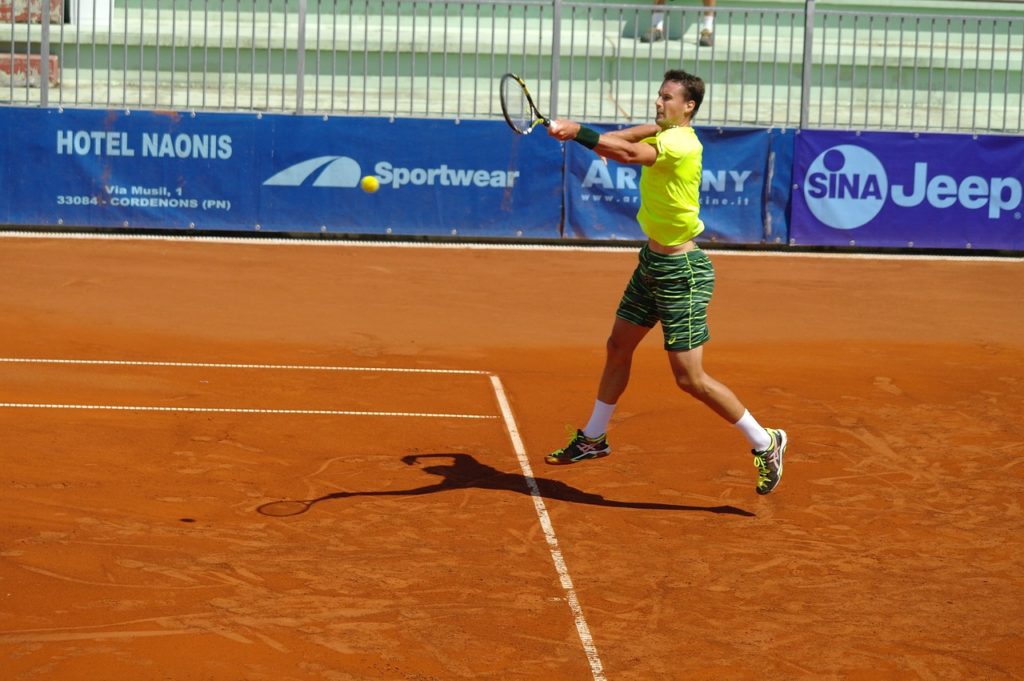
These types of courts abound in tennis clubs, mainly from Spanish-speaking countries such as Spain, Argentina, Chile, Portugal or Venezuela. Its construction is not excessively expensive, as is its maintenance.
Regarding the maintenance, we advise watering sporadically with water as a spray, at the same time, that it is convenient to distribute the clay dust correctly throughout the track to avoid accumulation and caking.
As for the type of game practiced on clay courts, the lifted blows at the bottom of the track, the left ones, or cut blows would stand out. The game is, in a way, antagonistic with the hard track game, much more aggressive. In addition, many people wonder how long a game of tennis lasts on this tennis court since the type of tennis game usually lengthens the points and consequently the hours played. Therefore, the duration of the points is usually much longer than any other surface.
Finally, we should take into account for the game on these courts, the use of specific tennis shoes, in order to facilitate the displacements, based on sliding through the clay, which not everyone gets.
Synthetic, Carpet Indoor Tennis Courts
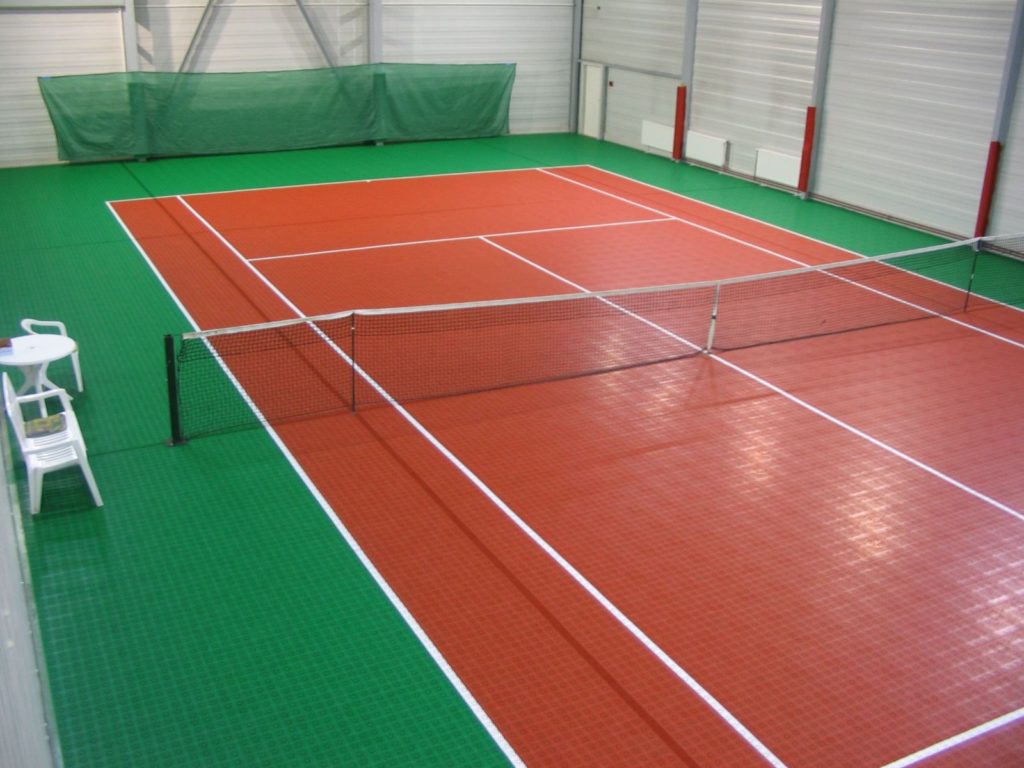
Just like when we talked about grass tracks, these types of tracks are not often found very often.
Its surface is constructed with materials such as synthetic resin, and the colors range from green, blue or salmon, in the case of indoor or covered tracks. When in the case of carpet courts are made up of a type of carpet specially designed for the practice of tennis.
This type of tennis courts have similar characteristics to the cement courts in the case of indoor courts, however, the carpet courts try to emulate lawn tennis courts.
We will find this type of tennis courts in those countries where they suffer eminently rainy weather. It should be noted these carpets are frequently found in countries such as Holland or Germany, where due to climatic reasons, the construction of these types of tracks is required.
As for the best-known tournaments played in this type of tennis courts, we could highlight ATP 250 such as St. Petersburg, Metz, Tokyo ATP 500, Basel, or of course, the London Masters Cup, the final climax of the ATP circuit.
On the other hand, the type of game that is usually used in this type of tennis courts is very similar to hard courts , being an aggressive and fast type of game, especially using flat or lifted serves, drives and setbacks, and taking advantage of the movements from one side to another of the rival.
As with the types of hard tennis courts, the importance of the correct use of shoes that allow you to play comfortably and that facilitate movement, is essential if you do not want to suffer accidents or accidental injuries.
What About Tennis Court Under the Sea?
Indeed, it is possible to find it! It is one more eccentricity of the society of the 21st century.
After boasting of having a high-rise tennis court built above the 1,000-foot Burj al Arab hotel, Dubai has “smeared” an architect to design an underwater tennis court.
Who would say there would be a kind of underwater tennis court
Polish architect Krysztof Kotala has proposed building a type of underwater tennis court located in the Persian Gulf, between the Burj al Arab and Palm Jumeirah Islands.
Designed with a huge curved roof, the underwater complex will be extended to accommodate seven types of tennis courts. The sports complex will also serve as an aquarium, with a coral reef on the roof, which will exhibit a lot of marine life for spectators and for players.
Conceived to create the illusion of a natural atoll, once done, the glass-covered track will add to another “eccentric” monument off the coast of Dubai.
However, engineers and developers have expressed their fears about the construction of the underwater tennis court, as it poses many challenges that, at the moment, seem impossible to overcome.
Some of the obstacles include creating a single piece of glass large enough to cover the structure and strong enough to withstand water pressure.
It is estimated that the transparent roof would require a continuous glass panel at least 108 feet wide to accommodate the stand and the spectators that will be there.
However, Kotala is comfortable with his innovative plans and is not willing to give them up, “This will be something original. It should be a place where there is a tradition of tennis. Dubai is perfect to find these courts for tennis matches.
How to Maintain Different Types of Tennis Court?
Maintaining a dry or fast clay type tennis court does not require any kind of effort or experience. It requires continuous observation combined with preventive maintenance measures.
With a basic understanding of the nature of the track and how it reacts to certain conditions, common sense can provide you with a guide to maintain it correctly.
The tennis court consists of three main components: a curved perimeter that prevents erosion and keeps the track in place; a concrete or cement base, which acts as a drainage area and a moisture reservoir, and the quick-drying surface.
For someone who deals with a type of fast-drying tennis court properly constructed, the first two elements should rarely be considered, if they ever do. The quick-drying surface itself is the part of the court that requires permanent attention.
Quick Drying Material for Tennis Courts
To properly care for a fast-drying track, it is important to understand some basic facts about the surface material. It is an extremely hard basaltic rock that is produced in a natural green color.
This rock is then milled into a range of finely graded particles with smaller dust-sized particles that act as a cohesive material when wet and larger particles provide drainage.
The quick-drying surface is preserved in a firm and unified layer by the presence of moisture and the application, when required, of compaction.
Regular Maintenance of a Tennis Courts
A clay court, made of dry and fast clay, requires regular care. In addition to times of bad weather or when a track has been closed during the winter, this means that it must be watered and maintained daily.
Even if the court has not been played or is not scheduled to play, watering and maintenance must still be performed. The main daily maintenance activities are brushing and raking.
The ideal sequence to maintain a court is to brush, water and rake. This is generally difficult to do since most of the watering is done during the night and nobody is usually available to brush the track at the end of the previous day’s game.
However, if possible, this sequence of actions is better, because brushing helps level and fill imperfections on the surface of the court to help them dry faster.
Water will tend to establish these imperfections if they are not corrected. In addition, a wet track is more difficult to redistribute the surface granulate to fill the grooves or level.
How to Play According to Each Type of Tennis Courts?
As a final prize for having come to read here, let’s summarize how to focus your game strategy according to the surface on which you usually play and know the type of game you should use.
Hardcourt Game
When we play hard court, we must take into account the liveliness of the ball, which requires moving very quickly and moving the opposite way. So, to fight and counteract your opponent’s tennis game, you must abuse moving from one side of the court to the other.
To do this, we must abuse both flat and lifted blows. Occasionally, we can also cut the rhythm with cuts or blows. Finally, in the same way, we have to be aware that the first serve is vital in these types of courts for tennis, so it is important to have a high percentage of first services and do as many “ace’s” as we can.
Clay court
This surface is usually known for the triumph of the typical “parabola” game. Outside of jokes, to be successful in your game on the clay dust tracks we must use ourselves physically, basing our game on lifted strokes and rhythm cuts with left-handed cuts and punches.
We must also take into account the movements of the rival, and ultimately, know how to slide correctly through the brick dust.
Game on the Grass Court
If you are a player of serve and volley, congratulations, this is the track where you should always play. If there is any surface where effective kicks and volleys are especially rewarded, it is without a doubt. In the grass tracks, we must keep in mind that the most common points are those of short duration, that’s why the type of serve and volley game. In this type of tennis courts, we must focus our strategy, based on flat and cut ball hits especially. And finally, we will try to win ¾ point just with the serve, in case of not getting the ace, finish winning it with a winner.
Indoor or Carpet Court
When we play on an indoor court we must be aware that, apart from the liveliness of the ball, there is a factor that is the “buoyancy” of the ball. In other words, this factor gives special relevance to players who base their strokes on the alternation of lifted strokes with flat and aggressive strokes.
Similar to the type of hard court game, abusing a first serve that solves a large part of the point is essential to subsequently “scratch” enough winner punches. Therefore, the lateral movement of the opponent with flat and lifted strokes, and going up to the net to finish off the points with volleys is a great option on which to base your game strategy.
Conclusion
If you have read this post about the types of courts until the end, we only have to congratulate you and encourage you to tell us your experiences or your opinion in the comments about this article or what you want, that we are between tennis players

